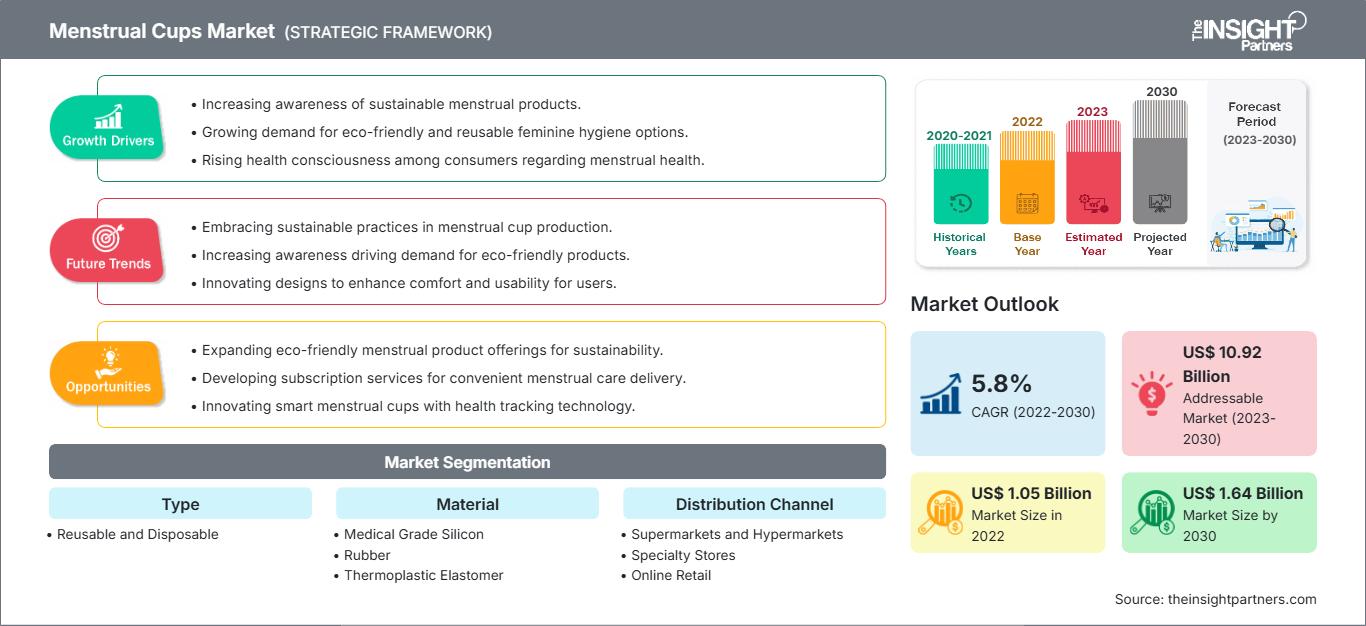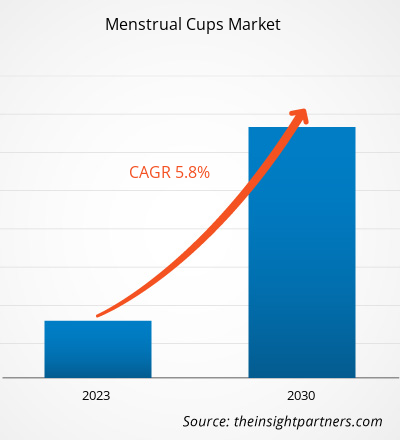[研究报告] 2022年,月经杯市场规模为10.5081亿美元,预计到2030年将达到16.4406亿美元;预计2022年至2030年的复合年增长率为5.8%。
市场洞察与分析师观点:
月经杯是一种可重复使用的钟形装置,专为月经期间的女性卫生而设计。这些杯子通常由医用级硅胶或橡胶制成,插入阴道收集经血,而不是像传统的卫生棉条或卫生巾那样吸收经血。它们形成密封以防止泄漏,并且可以佩戴长达12小时才需要清空,为一次性产品提供了一种可持续且经济高效的替代品。与传统的月经卫生用品相比,月经杯因其环保优势和长期成本节约而越来越受欢迎。
增长动力与挑战:
对可持续月经产品需求的激增是推动月经杯市场发展的主要动力。近年来,全球都在向可持续发展转变,消费者越来越意识到传统一次性月经产品对环境的影响。传统卫生巾和卫生棉条是塑料垃圾的重要来源,其生产需要消耗资源和能源。每年,平均每位女性会丢弃近 150 公斤不可生物降解的垃圾。仅在印度,大约有 1.21 亿女性和女孩平均每月使用 8 片一次性和不可堆肥的卫生巾,每月产生 10.21 亿片卫生巾垃圾,每年产生 123 亿片卫生巾垃圾,每年产生 11.3 万吨月经垃圾。随着人们寻求环保替代品,月经杯因其可重复使用的特性而成为主流选择。这种日益增强的环保意识促使消费者选择能够最大程度减少生态足迹的产品,从而推动了月经杯的需求。
可持续月经产品需求的增长与倡导女性健康和福祉的广泛运动密切相关。消费者越来越重视那些不仅环保,而且安全且有益于健康的产品。月经杯通常由医用级硅胶、橡胶或热塑性弹性体制成,被认为安全卫生,可以降低传统产品中常见的刺激和过敏反应风险。月经杯与环境可持续性和女性健康的契合增强了它们的吸引力,并成为其日益普及的驱动力。
自定义此报告以满足您的要求
您将免费获得任何报告的定制,包括本报告的部分内容,或国家级分析、Excel 数据包,以及为初创企业和大学提供超值优惠和折扣
月经杯市场: 战略洞察

- 获取本报告的主要市场趋势。这个免费样本将包括数据分析,从市场趋势到估计和预测。
您将免费获得任何报告的定制,包括本报告的部分内容,或国家级分析、Excel 数据包,以及为初创企业和大学提供超值优惠和折扣
月经杯市场: 战略洞察

- 获取本报告的主要市场趋势。这个免费样本将包括数据分析,从市场趋势到估计和预测。
各种倡导团体、非政府组织和政府倡议都在大力呼吁月经产品的可持续性,旨在提高公众对一次性用品环境影响的认识。推广可持续月经的活动在教育公众了解月经杯等可重复使用替代品的益处方面发挥了至关重要的作用。可持续月经习惯的日益普及和认可,有助于消费者观念的积极转变,从而促进月经杯的接受度和普及率。
年轻一代消费者更注重环保选择,这也推动了对可持续月经产品的需求。千禧一代和Z世代尤其推动了包括个人护理在内的各行各业对可持续和符合道德标准产品的需求。这些人群的意识和偏好影响着市场趋势,而月经杯作为一种可持续且具有前瞻性的选择,与他们的价值观高度契合。随着这一群体购买力的不断增长,对月经杯的需求也将增长,从而巩固其作为可持续月经用品的市场领先地位。
然而,消费者的认知和缺乏认知是月经杯市场发展的重大制约因素,影响了全球的普及率。由于缺乏全面的教育和宣传活动,许多人仍然不了解月经杯的好处。对该产品及其优势(例如成本效益、减少环境影响和延长佩戴时间)的不熟悉,导致潜在用户不愿放弃传统月经用品。这种知识的缺乏会导致误解和顾虑,阻碍月经杯作为一种可行实用的替代品被更广泛地接受。
不愿使用月经杯通常是因为担心放入和取出困难。一些消费者认为使用月经杯的学习曲线是一个障碍,认为这需要一定的技巧或舒适度,而他们可能不具备。对月经杯的简单使用和潜在健康益处缺乏了解,加剧了这种担忧。要克服这些先入为主的观念和误解,需要有针对性的教育工作,强调月经杯的易用性、舒适性和积极的环境影响。通过解决这些问题并提高认知度,市场可以努力消除误解,并在潜在用户中树立更积极的看法。
报告细分和范围:
全球月经杯市场根据类型、材质、分销渠道和地域进行细分。根据类型,市场分为可重复使用型和一次性型。根据材质,市场分为医用级硅胶、橡胶和热塑性弹性体。根据分销渠道,市场分为超市和大卖场、专卖店、在线零售和其他。按地域划分,全球月经杯市场大致分为北美、欧洲、亚太地区、中东和非洲以及南美和中美洲。
细分分析:
根据类型,月经杯市场分为可重复使用和一次性两类。预计可重复使用月经杯在2022年至2030年期间的复合年增长率最高。可重复使用月经杯代表了月经卫生领域一场可持续且经济高效的革命。这些钟形杯通常由医用级硅胶、橡胶或热塑性弹性体制成,可插入阴道收集经血,而不是像传统卫生棉条或卫生巾那样吸收经血。材料的柔韧性和柔软性确保了舒适性和易用性,并能适应用户的生理结构。可重复使用月经杯最长可佩戴12小时,提供防漏保护,让用户更灵活地管理经期。它们最显著的优势之一是对环境的影响,因为它们可以重复使用。这些杯子显著减少了月经废物的产生量,有助于形成环保的月经护理习惯。此外,长期节省成本以及无需定期购买一次性产品的便利性,使可重复使用的月经杯成为寻求可持续且实用的月经卫生替代品的用户越来越受欢迎的选择。
区域分析:
月经杯市场分为五个主要区域:北美、欧洲、亚太地区、南美和中美以及中东和非洲。2022 年,北美占据全球月经杯市场的主导地位,该地区的市场价值为 3.9541 亿美元。欧洲是第二大贡献者,占全球市场的 30% 以上。预计亚太地区在 2022 年至 2030 年期间的复合年增长率将超过 5%。亚太地区月经杯需求激增可归因于多种因素,包括文化变迁、意识增强以及女性健康日益重要。在许多亚洲国家,打破月经禁忌的运动日益兴起。
新冠疫情影响:
新冠疫情最初阻碍了全球月经杯市场的发展,原因是制造工厂关闭、劳动力短缺、供应链中断以及金融不稳定。新冠疫情爆发导致经济放缓,各行各业的运营中断,抑制了月经杯的供应。此外,各种商店关门,也限制了月经杯的销售。尽管如此,随着 2021 年各国取消先前实施的限制措施,月经杯业务开始复苏。此外,各国政府实施的新冠疫苗接种运动缓解了疫情,导致全球商业活动增加。随着封锁和行动限制的放松,包括月经杯市场在内的多个市场均报告了增长。
月经杯市场区域洞察
The Insight Partners 的分析师已详尽阐述了预测期内影响月经杯市场的区域趋势和因素。本节还探讨了北美、欧洲、亚太地区、中东和非洲以及南美和中美洲的月经杯市场细分和地域分布。
月经杯市场报告范围
| 报告属性 | 细节 |
|---|---|
| 市场规模 2022 | US$ 1.05 Billion |
| 市场规模 2030 | US$ 1.64 Billion |
| 全球复合年增长率 (2022 - 2030) | 5.8% |
| 历史数据 | 2020-2021 |
| 预测期 | 2023-2030 |
| 涵盖的领域 |
By 类型
|
| 覆盖地区和国家 | 北美
|
| 市场领导者和主要公司简介 |
|
月经杯市场参与者密度:了解其对商业动态的影响
月经杯市场正在快速增长,这得益于终端用户需求的不断增长,而这些需求的驱动因素包括消费者偏好的转变、技术进步以及对产品优势的认知度不断提高。随着需求的增长,企业正在扩展产品线,不断创新以满足消费者需求,并抓住新兴趋势,从而进一步推动市场增长。

- 获取 月经杯市场 主要参与者概述
竞争格局和主要公司:
Nixit、Lunette Global、Lena Cup LLC、Diva International Inc.、Saalt、Pixie Cup、June Cup、Cora、The Flex Company 和 Blossom Cup 是全球月经杯市场的知名参与者。
- 历史分析(2 年)、基准年、预测(7 年)及复合年增长率
- PEST和SWOT分析
- 市场规模、价值/数量 - 全球、区域、国家
- 行业和竞争格局
- Excel 数据集
近期报告
客户评价
购买理由
- 明智的决策
- 了解市场动态
- 竞争分析
- 客户洞察
- 市场预测
- 风险规避
- 战略规划
- 投资论证
- 识别新兴市场
- 优化营销策略
- 提升运营效率
- 顺应监管趋势




















 获取免费样品 - 月经杯市场
获取免费样品 - 月经杯市场